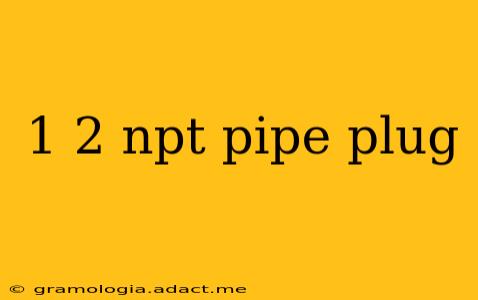Finding the right pipe plug is crucial for ensuring the safety and integrity of your plumbing system. This guide focuses specifically on 1/2" NPT pipe plugs, covering their applications, materials, and how to choose the best one for your needs. We'll also address common questions surrounding these essential components.
What is a 1/2" NPT Pipe Plug?
A 1/2" NPT pipe plug is a threaded fitting used to seal the end of a 1/2-inch National Pipe Taper (NPT) pipe. NPT threads are tapered, meaning they create a tighter seal as they are tightened. This makes them ideal for applications requiring a leak-proof connection under pressure. The plug itself is typically a solid piece of metal or plastic, designed to be screwed into the end of the pipe, effectively blocking the flow and preventing leaks.
What are 1/2" NPT Pipe Plugs Used For?
1/2" NPT pipe plugs have a wide range of applications across various industries. Some common uses include:
- Sealing unused pipe openings: This prevents leaks, debris from entering the pipe, and potential corrosion.
- Temporary closures: During maintenance or repairs, plugs provide a convenient way to temporarily block off sections of pipe.
- Permanent closures: In some cases, plugs are used to permanently seal off sections of pipe that are no longer needed.
- Industrial applications: Many industrial processes utilize NPT threaded fittings, and plugs are essential for system integrity and safety.
What Materials are 1/2" NPT Pipe Plugs Made From?
The material of a 1/2" NPT pipe plug influences its durability, corrosion resistance, and suitability for different applications. Common materials include:
- Brass: Offers excellent corrosion resistance and is suitable for a wide range of applications.
- Steel: Provides high strength and durability, but may require additional protection against corrosion, often achieved through galvanization or other coatings.
- Plastic (e.g., PVC, Nylon): Lightweight and less expensive than metal, but may not be suitable for high-pressure or high-temperature applications. They are often a good choice for less demanding applications or where corrosion resistance is paramount in certain environments.
How to Choose the Right 1/2" NPT Pipe Plug?
Selecting the appropriate 1/2" NPT pipe plug depends on several factors:
- Pipe material: Ensure the plug's material is compatible with the pipe material to prevent corrosion or other adverse reactions.
- Pressure rating: Choose a plug with a pressure rating that exceeds the expected pressure in the pipe system.
- Temperature rating: Consider the operating temperature of the system and choose a plug that can withstand it.
- Application: The specific use case will influence the choice of material and construction.
What are the Different Types of 1/2" NPT Pipe Plugs?
While the basic function remains the same, subtle variations exist:
- Standard plugs: These are the most common type, offering a simple and effective seal.
- Plugs with sealing washers: Some plugs incorporate sealing washers for an enhanced leak-proof seal.
- Plugs with different head designs: Head designs may vary slightly, depending on the manufacturer and intended application.
What Size Wrench Do I Need for a 1/2" NPT Pipe Plug?
The wrench size needed will depend on the plug's design and the material it's made of. It's always best to refer to the manufacturer's specifications or use a wrench slightly larger than the plug's size to avoid damaging the fitting. Usually, an adjustable wrench (crescent wrench) or open-end wrench of a slightly larger size will be sufficient.
How Do I Install a 1/2" NPT Pipe Plug?
Installation is relatively straightforward:
- Clean the pipe threads: Ensure the threads on the pipe are clean and free of debris.
- Apply pipe sealant (optional): A sealant can enhance the seal and prevent leaks.
- Screw the plug into the pipe: Tighten the plug by hand initially, then use a wrench to tighten it further. Be careful not to overtighten, which can damage the plug or pipe.
By carefully considering these factors, you can choose the correct 1/2" NPT pipe plug for your needs, ensuring a safe and effective seal. Remember to always consult relevant safety guidelines and manufacturer specifications before working with plumbing systems.
